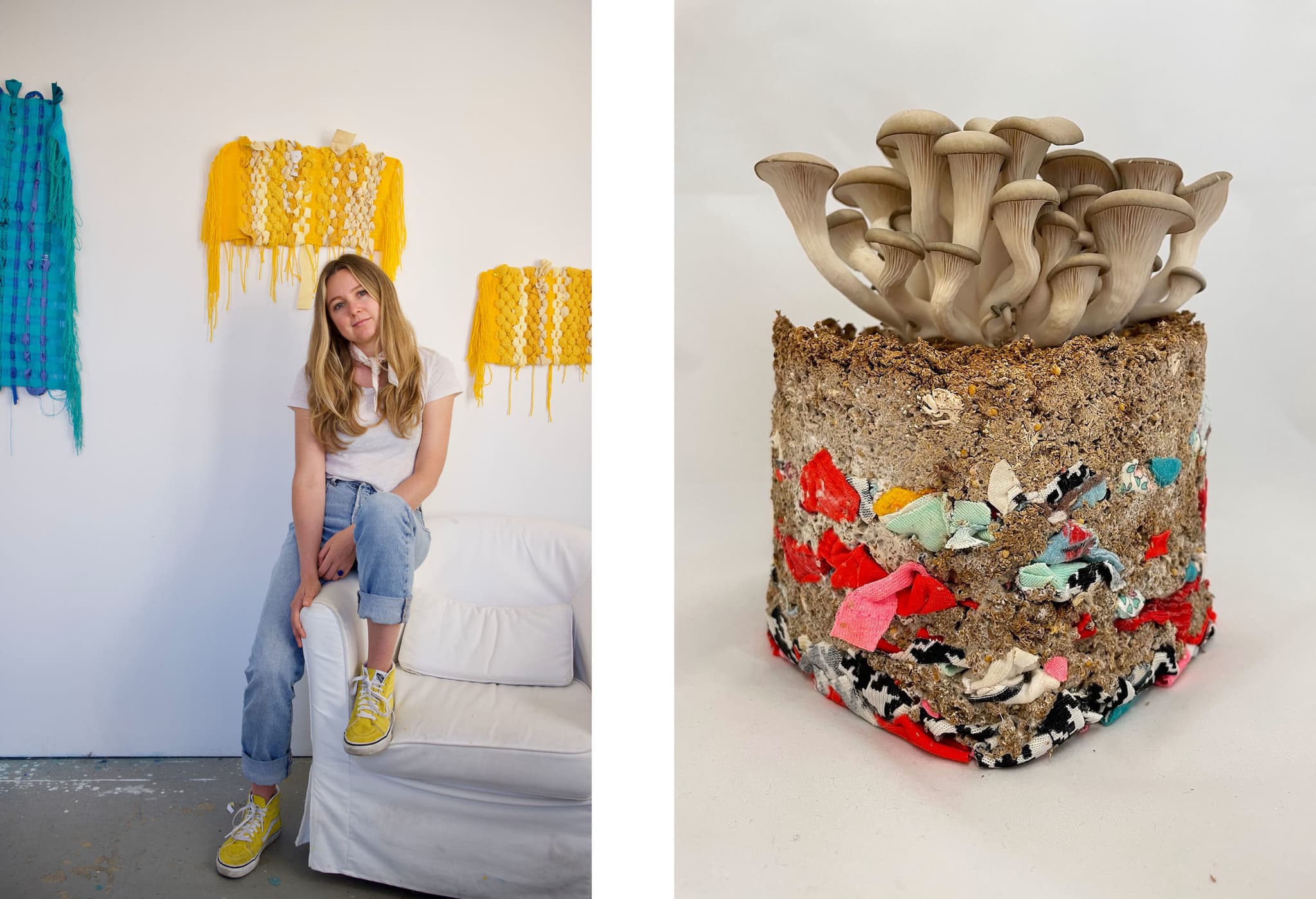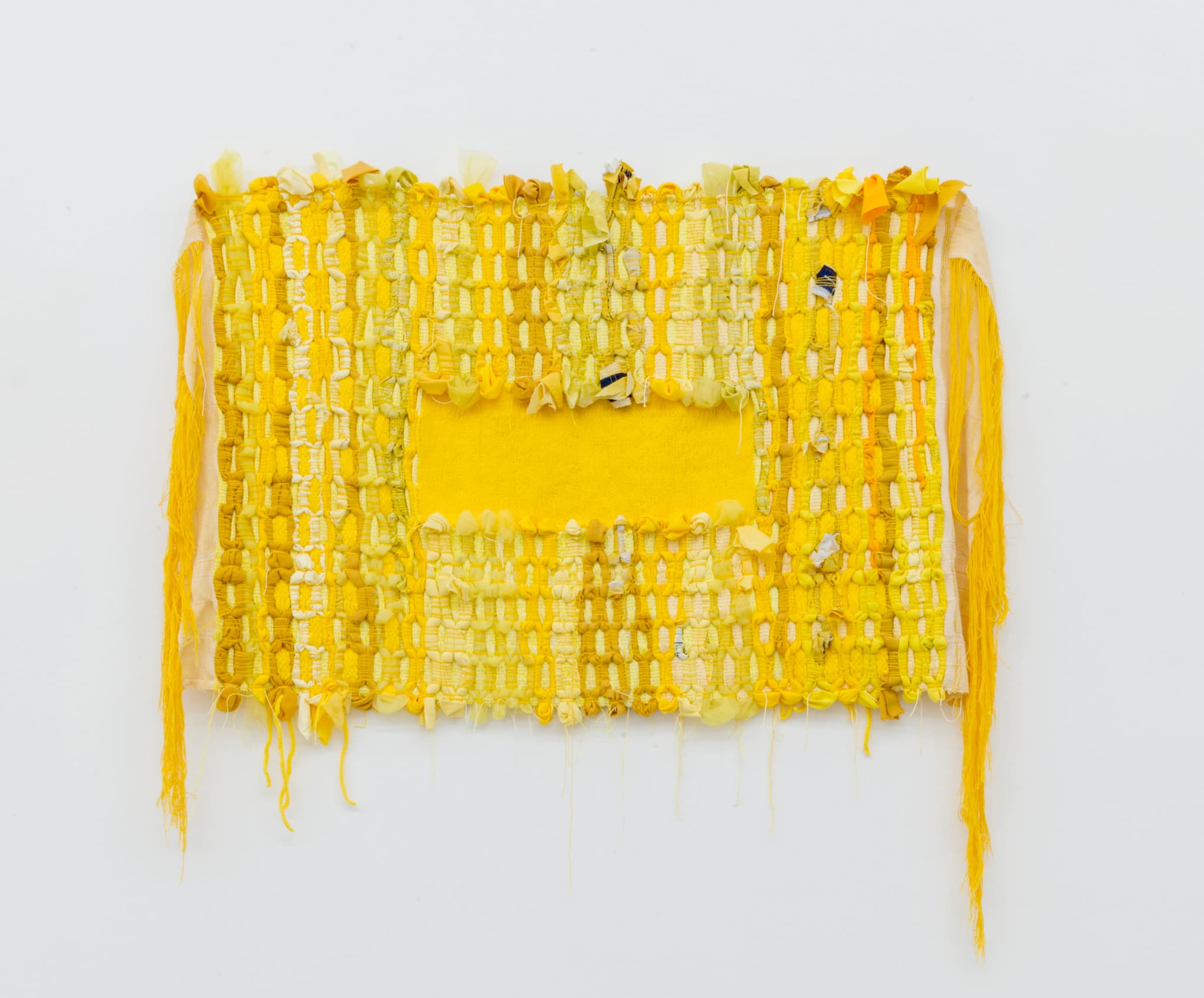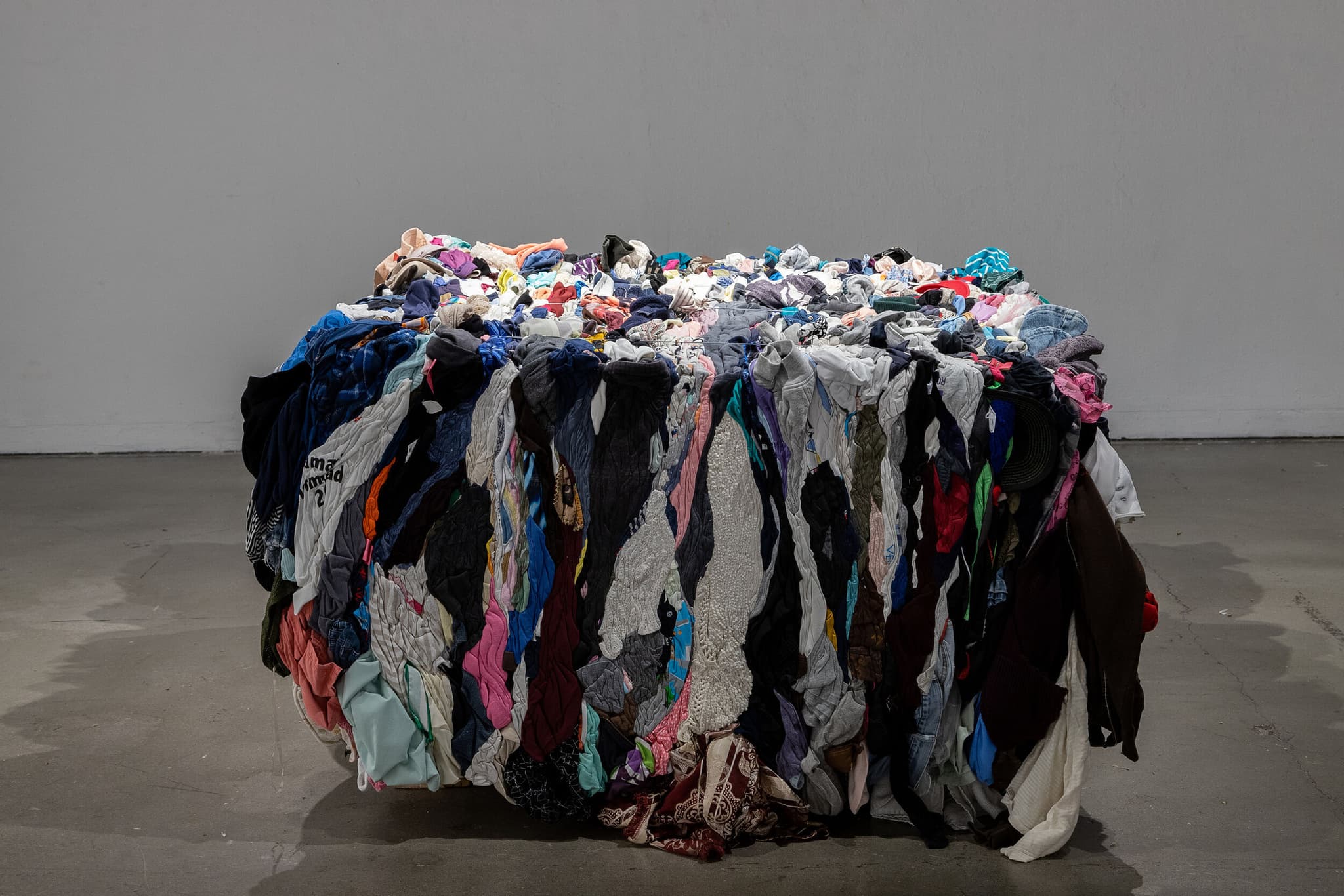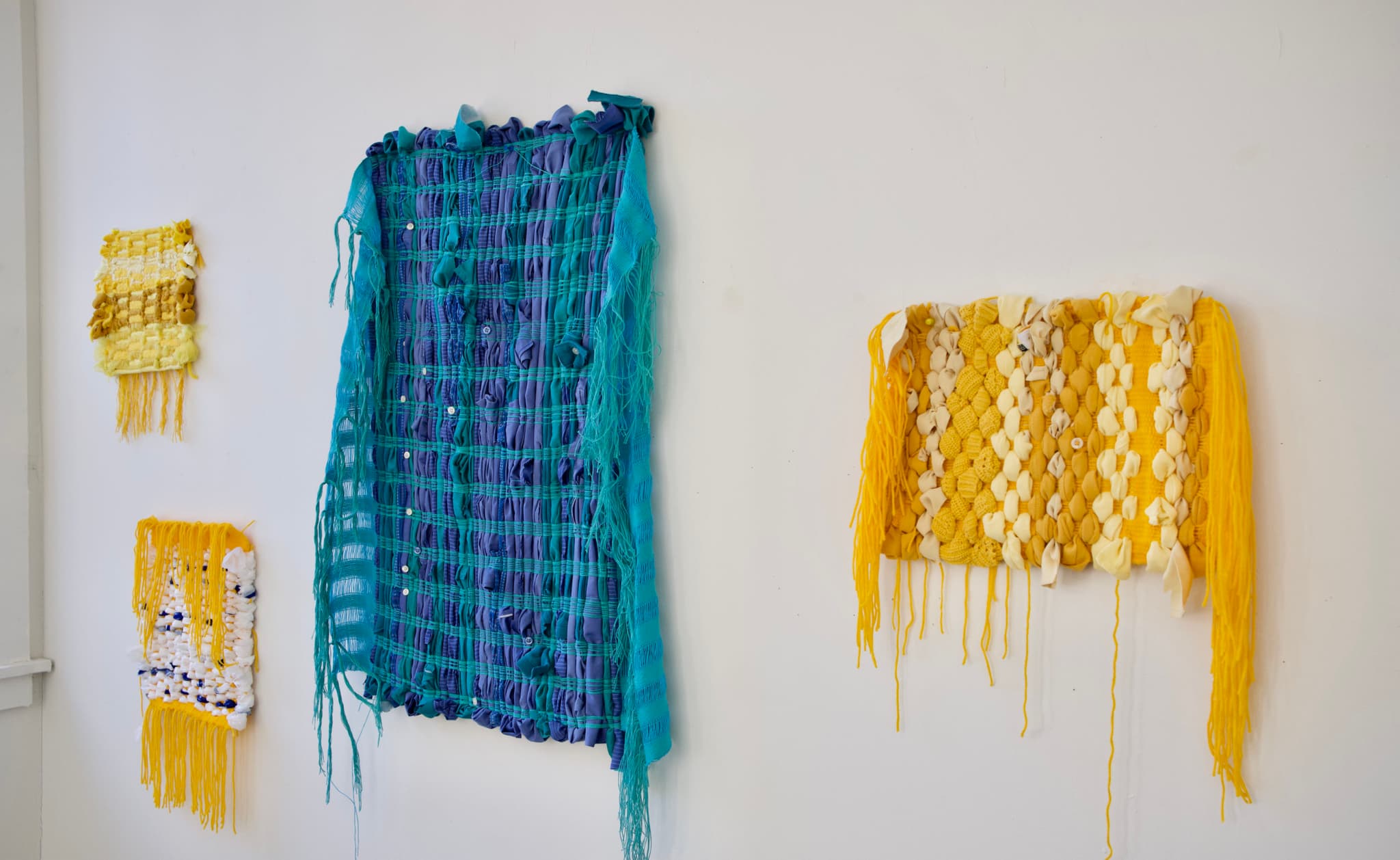In the wake of climate change awareness has come the question whether art surrounding the climate crisis will inspire change swiftly and promptly—and more critically—whether the art world can simultaneously avoid contributing to the problem. Quite unlike her contemporaries, sculptor and textile artist Minga Opazo does not merely regurgitate climate change issues in her art, but approaches her practice as a scientific experiment to find resolution.
Layering grass, rock, and textiles into large, vertical stacks, Opazo’s body of work, including Core Sample (2020) and Terron (2021), manifests a probable future that makes use of an unnatural geological makeup. Among the layers of dirt are second-hand fabrics woven into Chilean patterns, which recall the artist’s familial practice and her native country’s standing as fast fashion’s final burial grounds. Her use of recycled materials serves to identify the excess waste caused by non-biodegradable, mass-produced clothing, and the unfathomable amounts of textiles disposed of in vulnerable countries like Chile and those in West Africa. Opazo, now working with mycologists at University of California, Riverside to degrade the plastic fibers of the discarded clothing in her works, creates art that not only acknowledges the unjust socio-cultural underpinnings and environmental devastation of the textile industry, but actively finds a solution to break down once-thought imperishable fabrics.
I recently spoke with Minga about her work and short-term residency at MASS MoCA in early April, where she was able to focus on the time-intensive practice of weaving. While there, she took advantage of the facility’s looms, studied MASS MoCA’s monumental installations for her own large-scale works, and made significant headway on her wall-hanging series, like (Yellow Weaving) Plenty I (2021), that directly intertwined weaving with mycelium. The following conversation has been edited and condensed.

(left) Portrait of Minga Opazo in her MASS MoCA studio. Photo by Karen Dias. (right) Minga Opazo, Redress, 2021. Recycled clothing and mycelium. Courtesy the artist.
Haley Clouser: Thank you for speaking with me again, Minga! I wanted to begin our conversation with some background on who you are and how you came into your practice.
Minga Opazo: Of course! As you know, I’m from Chile. I grew up in a family of women who are textile crafters, but they are more focused on sewing and weaving. My grandma taught me how to make clothing. My mom and my aunt owned a store together in Chile, and they made their own clothing. I came into weaving because I wanted to learn different techniques, and Chilean culture has a really rich textile history. About seven years ago, I learned from one of the masters in Chile and it was a really interesting experience for me. Chilean techniques are very different from Occidental weaving because you pull the thread through the floor. The floor looms here in the United States are faster to weave and more industrial.
HC: Do you use a combination of these weaving techniques—the Chilean and Western—or do you lean more toward one or the other?
MO: It’s a combination. Before graduate school, I was doing a lot of work that dealt with immigrating to the United States. When I moved here, I was 16, I didn’t know English, and I went to a big public high school, so there was a lot of “understanding my place.” I feel like, as someone who immigrated, there’s always going to be that kind of dialogue. Though it’s been thirteen years, I feel like my work is always going to have that combination of my background.

Minga Opazo, (Yellow Weaving) Plenty I, 2021. Recycled clothing, cotton string. Photo by Antoine Midant.
HC: Could you talk about the materials you use and how you source them?
MO: I use recycled materials and clothing. When I started my research at graduate school, I started looking deeply into the textile industry and fast fashion, and how much waste that creates. Then, I discovered that all that waste is shipped to Africa and Chile, specifically the Chilean desert. The desert in Chile has a rich textile history. There used to be cotton that grew in all of these colors, not just white, but they disappeared because of GMOs. There is also this tribe, called Awakhuni, that used to be in the desert. All of the mummies that the tribe buried were wrapped in textiles, but those textiles were taken away and shipped to European museums. And so, now we have a new wave of textiles in the same sites or same areas of Chile, but they are textiles that have been discarded. So to me, that was a weird connection.
I also source my materials in the United States, and I work with a little thrift shop in Ventura, outside of L.A. They go through clothing so fast that they donate clothing for me to use. But also, they just have so much of it—it’s just such a problem.
HC: Could you talk a bit about the significance of using second-hand materials?
MO: It started because we have so much waste in general, so I was like, “I’m just going to use what’s there.” And then that significance started growing when I started doing research on how much waste we have. Not just the waste we create to make the garments, but also the waste that we make after the fact, when we don’t want that garment anymore. Also, most of the cheap clothing that we buy has plastic or polyester in the fabric. Polyester doesn’t decompose because it’s plastic mixed with natural fibers. So, I specifically use these materials in my work to allude to the fact that plastic doesn’t decompose and contributes to textile waste.
HC: So, you use these second-hand materials sourced from thrift shops and you weave them through a Chilean-esque tradition. And, correct me if I’m wrong, you also do this to acknowledge the fact that fast-fashion industries and textile waste is often sent to Chile as well as African countries?
MO: To me, the whole cycle is just so interesting. It’s like the world is upside down in my mind. The majority of cotton is made in India and parts of Texas. And then they send it to China to make the textile. Then, they send it to Indonesia or Cambodia to make the garments—I mean don’t get me started on how bad the labor laws are there. They then send it to the United States or Europe to sell the garment. Usually, a garment is used seven times and then it is discarded. They then put it in a container and ship it to Chile and Africa. I’m alluding to this process by using recycled material and Chilean weaving.
HC: Essentially, you practice a lot of sustainability or you’re trying to promote it. How else do you work to achieve this?
MO: Over the past five years, I’ve been making sculptures and works showing the problem [with fast fashion]. I think it’s very important to show the problem, but I was kind of stuck with the concept and kept thinking, “What am I doing? I’m just showing the problem.”
I wanted to continue the conversation by trying to find a solution for textile waste. I started collaborating with Danielle Stevenson, a mycologist at UC Riverside. I had read articles on mushrooms eating plastic. Textiles are natural fibers, like cotton or hemp, mixed with plastic. I thought it would be easier for the mushroom to digest the textiles because they might go for the cotton or the natural fibers and then encounter the plastic. We started doing oyster mushrooms first, and now we’re experimenting with other liquid mycelium. I’m most excited about Pestalotiopsis microspora, which is supposed to digest the plastic faster. My dream is to do big installations with mushrooms eating the works. But for now, I’m doing a sculpture piece that is 4′ by 2′, so still pretty large. I think it’s important to have scale not just because of the grandiose impression, but to show this is a big problem.

Minga Opazo, Buy bulk save more, 2020. Recycled clothing and wood. Photo courtesy the artist.
HC: You’re also contributing to a resolution by creating these larger sculptures. So even though they’re grandiose, there’s more fabric being degraded. In a way, you’re just making a bigger resolution, right?
MO: Yes! I think that part of the concept is to show the problem, so when you’re in the gallery and you’re encountering a big piece of work, you realize it is massive.
This whole conversation is also about trash and trash displacement. You never see it because it’s just placed outside your house and then you never see what happens to it. I do a lot of research in dumps; I go to dumps a lot. I think all the trash that people generate is just fascinating. It’s kind of like an archeological dig. So in some ways, I feel like an archaeologist of the future.
HC: On this aspect of “grandiose” or large sculptures and also being a “futuristic archeologist,” could you talk about some of the origins of your mushroom works? From what I understand, your works like Core Sample (2020) and Terron (2021) were the earlier stages of these mushroom works?
MO: The whole point of Core Sample (2020) was to imagine a new archaeology. In Chile, they bury a lot of the textiles because they are trying to get rid of them. I was thinking of what would happen if you placed core sample of this site into a gallery, so I recreated that. All of the works are made of mud and textiles, then grass started growing out of the sculpture, so that inspired me to do Terron (2021) and Our Lawn (2022).
These two pieces were also reflective of me living in L.A, where there are so many manicured lawns that shouldn’t be there. And this was interesting to integrate into my sculptures. Lawns also have this whole history of labor and textiles have a history of labor, so I was trying to combine them both.

Opazo’s MASS MoCA studio and works in progress. Photo by Karen Dias.
HC: To keep going on this notion of labor, I think it’s interesting that the textiles you’re using have a history of labor, and you’re also performing labor to create the weavings and also create the work itself. Does that spark any thoughts with you?
MO: It’s so funny that you mentioned that because a lot of people are surprised and ask how I even do my work. I basically used my Prius to go and get dirt, which spans over a period of 37 hours. So I do like connecting with the idea of labor in that way. I also know how much time that goes into making the garment, and how much time into the craft. With the layers, you can see all the time that goes into these works.
HC: It’s interesting that people are coming to your work and thinking, “Wow, that must’ve taken a long time to make.” But your works are made of clothes that your viewers encounter all the time, and those clothes take up “X” amount of hours to make too. It seems like there’s this disconnect or desensitization of people in that they don’t immediately think about how much time it took to make the clothes on their back, but they can see that in your work. So, it feels like you’re reemphasizing that issue. Our Lawn (2022) confronts this idea of desensitization, could you speak more about it and its activation by visitors?
MO: I made the sculpture floor level, so you can step on it. I had a yellow watering pail so people could water it and take care of it, making everyone perform labor. I liked the idea of flipping the labor onto the viewer.

(left) Minga Opazo, Terron, 2021. Recycled clothing, mud, wood, grass. Photo courtesy the artist. (right) Minga Opazo, Our Lawn, 2022. Recycled clothing, mud, wood, grass. Photo by Antoine Midant.
HC: It’s definitely a very embodied experience. When people walk on it, they realize that they are part of the problem, and that these are clothes that they could have worn and thrown away. The realization comes from interacting with it.
Could you tell us now about what you are working on at your MASS MoCA residency? What about the museum and its resources drew you to it?
MO: First, the museum is incredible; the scale of the shows really drew me in. Because my work is so big, I wanted to see how artists are using big spaces. Second, they also have looms. I applied because I really wanted to use the looms and focus on the weaving. The residency allowed me to dedicate time to weave, which is a very labor and time-intensive practice that needs strict focus.
HC: Makes sense! So you are continuing your weaving there to create new work?
MO: All my other work is very conceptual and I think I have a very solid ground of what I’m doing, but the thing I was struggling with most was my weaving. They are really pretty and nice, but I wanted to push that forward. So, I am now learning to insert pockets into my weaving and introducing the mycelium there. I let the mushrooms collaborate with me and my weaving. Compared to my other work where I use the mycelium to do a certain thing, these works allow the mushrooms to do whatever they want to do; they can start growing in the woven pockets and then eat the fabric.
HC: It’s ironic that you’re creating the garment back into a piece of clothing. It seems like there is a lot of recall in your work; your newer works at MASS MoCA recall both your earlier woven wall hangings and mycelium sculptures. It’s also interesting that you’re transforming your floor-bound sculptures, like Our Lawn (2022) or Core Sample (2020), into wall hangings or mixing the two. What was your thought process with making them into wall hangings, and what does that signify to you?
MO: I did these two weavings in my last show that are very geometrical. I wasn’t really thinking about painting, but once they go on the wall they are very painterly. They have these swatches of plain weaving in the middle with the textured, woven-recycled textiles surrounding it, like (Yellow Weaving) Plenty I (2021). My mom saw them and thought they looked like Josef Albers paintings. So I realized that by putting these on the wall, I’m creating conversations about painting and abstract painting. It’s interesting to me to create works that resemble “high art” and have the mushrooms disintegrating “high art.” I am now thinking of creating two woven wall hangings, where one is disintegrated by mushrooms. Since mycelium is a fungus, it would drip and stain the wall and floor. I like taking the concept of “high art” and clean white galleries, and degrading them.
Haley Clouser is the Curatorial Fellow at deCordova Museum and Sculpture Park as well as an independent curator and writer. She lives and works between Boston and Richmond, VA. Her writing has been published in Burnaway and NUMBER INC.





